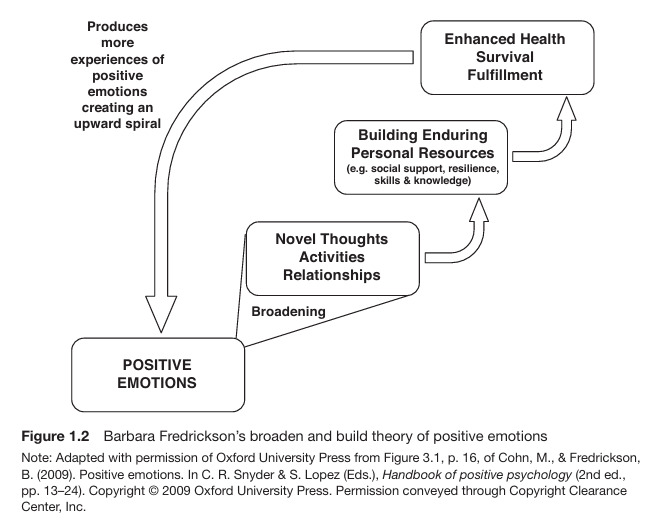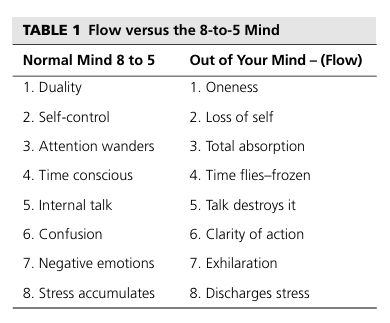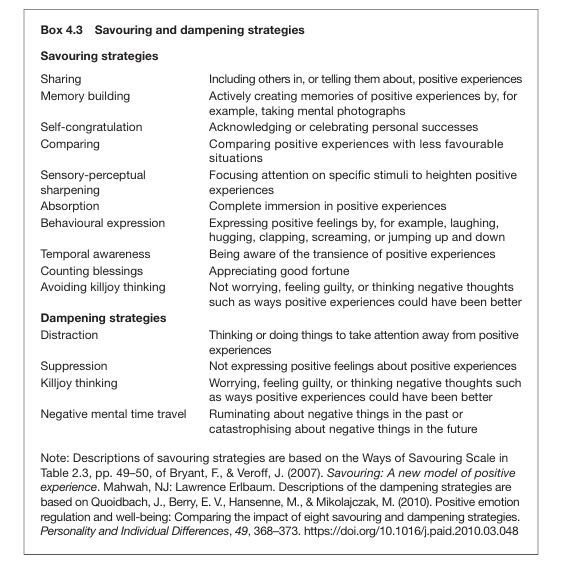Positive Emotions
Positive emotions and well-being are intricatly related. Positive emotions are a subset of emotional experiences that enhance our psychological and physical well-being. They are characterized by feelings of cheerfulness, joy, contentment, and happiness. Unlike negative emotions, which are often associated with distress and discomfort, positive emotions contribute to a more fulfilling and enriched life experience.
Seligman (2002) classifies positive emotions into three categories–
- Those associated with the past
- Those associated with the present
- Those associated with the future.
Positive emotions associated with the future include optimism, hope, confidence, faith and trust. Similarly, the main positive emotions associated with the past are Satisfaction, contentment, fulfilment, pride and serenity.
Read More- Positive Emotions
Positive Emotions & Well-being
Happiness, defined by frequent positive emotions and life satisfaction, is linked to well-being. People in a positive mood are more tolerant, compassionate, focused on others, and generally better to be around.
Positive emotions help people respond more flexibly and creatively to challenges (broaden-and-build theory, Fredrickson). In contrast, negative emotions often lead to self-absorption and focus on personal problems.
Positive emotions expand our view of the world, making us more receptive to new ideas and experiences.
Positive Emotion and Success
Research by Lyubomirsky and colleagues (2005) demonstrates that people who experience more positive emotions are more likely to be successful in various aspects of life. This includes better relationships, higher achievement in their careers, improved physical health, and greater financial stability. Positive emotions like joy, optimism, and contentment do more than just make us feel good; they have tangible effects on behavior and outcomes in life.
- Better Relationships- Happy people are more likely to engage in positive social behaviors, such as empathy, generosity, and cooperation, which strengthen friendships, romantic relationships, and professional networks.
- Enhanced Problem-Solving and Coping Strategies- Positive emotions broaden an individual’s mindset and thinking, making them more creative and flexible in solving problems. This fosters better decision-making and the ability to cope with stress.
- Increased Productivity and Success at Work- Happy employees tend to be more engaged, productive, and motivated, which can lead to greater career achievements and opportunities for advancement.
- Improved Physical Health- Positive emotions contribute to better health outcomes by reducing stress and promoting healthier lifestyles. This, in turn, enhances energy levels, resilience, and performance.
Upward Spiral of Well-Being
The relationship between happiness and success can be viewed as a positive feedback loop. When people experience positive emotions, they are more likely to engage in behaviors that increase their chances of success. This success, in turn, reinforces positive emotions, creating an upward spiral of well-being.
This concept aligns with Fredrickson’s broaden-and-build theory, which suggests that positive emotions broaden an individual’s attention and thinking, enabling them to build personal resources such as skills, knowledge, and relationships. These resources not only help individuals achieve success but also provide a buffer against challenges, making them more resilient in the face of adversity.

The Upward Spiral Caused by Positive Emotions
Positive Emotions and Flourishing
Flourishing vs. Languishing
- Flourishing involves thriving in life with emotional, psychological, and social well-being. Flourishing individuals often experience joy, engagement, and meaning in what they do.
- Languishing is a more stagnant state where individuals may not be clinically depressed but lack energy, enthusiasm, and a sense of accomplishment or purpose. It is sometimes described as “living a life of quiet despair.”
Critical Positivity Ratio
Fredrickson and Losada’s (2005) research on the critical positivity ratio suggests that a specific balance between positive and negative emotions is essential for flourishing. According to their findings, individuals need to maintain a 2.9:1 ratio of positive to negative emotions to experience flourishing. This ratio means that for every negative emotion, nearly three positive emotions are needed to maintain emotional balance and psychological growth.
- Below the Ratio (Languishing)- If individuals experience more negative emotions or fall below this critical ratio, they are more likely to be in a state of languishing. This imbalance can lead to stagnation and disengagement, preventing individuals from achieving their full potential.
- Above the Ratio (Flourishing)- A positivity ratio of around 2.9:1 or higher contributes to flourishing, allowing individuals to broaden their perspectives, build resilience, and foster meaningful connections.
Impact of Positivity Ratio on Mental Health
A higher positivity ratio is linked to improved mental health outcomes. People who maintain this balance of emotions often report:
- Better mental health- A flourishing individual is less likely to experience anxiety, depression, or other mental health challenges.
- Stronger social relationships- Positive emotions encourage more positive social interactions, which in turn foster deeper and more meaningful relationships.
- Greater life satisfaction- People with higher positivity ratios tend to feel more fulfilled and satisfied with their lives, experiencing greater personal growth and purpose.
Fredrickson’s broaden-and-build theory helps explain this. Positive emotions not only make us feel good in the moment but also broaden our awareness, making us more open to new experiences and opportunities. This openness helps build long-term resources, such as stronger relationships, skills, and resilience, which contribute to flourishing.
The Upper Limit of Positivity
While positive emotions are crucial for well-being, Fredrickson and Losada also identified potential drawbacks when positivity becomes excessive. Their research suggests that an extreme positivity ratio — such as 11.6:1 or higher — can actually be detrimental.
- Drawbacks of Excessive Positivity- Too much positivity can lead to a loss of perspective, where individuals become overly optimistic or disconnected from reality. Excessive optimism can result in underestimating risks, poor decision-making, and lack of preparedness for challenges.
- The Importance of Negative Emotions- Negative emotions, though unpleasant, serve essential functions for personal growth. They help individuals identify problems, confront challenges, and develop resilience. A balance between positive and negative emotions ensures that people remain grounded while also growing emotionally and psychologically.
Flow Experiences
Flow is a state of total immersion and absorption in an activity, where a person loses track of time and performs at their best. It often occurs when the challenge level matches the person’s skill.

Characteristics of Flow State
Characteristics of Flow
The characteristics of flow includes-
1. Total Absorption and Focus- In a flow state, individuals are completely absorbed in the task at hand. Their attention is fully focused on the activity, and there is little room for distraction. This total concentration allows for peak performance and deep engagement. During flow, there is a merging of action and awareness. People lose their self-consciousness, meaning they are not concerned with how they look, their status, or how others are perceiving them. They are “lost” in the activity.
2. Challenge-Skill Balance- Flow occurs when the challenge of the activity matches the individual’s skill level. If the task is too easy, boredom sets in, and if it is too difficult, anxiety may take over. Flow happens in the “sweet spot” where the challenge is just enough to stretch one’s abilities without overwhelming them. The challenge and skill levels can shift throughout the activity, but flow is maintained as long as there is a continuous balance. This dynamic tension keeps the person engaged and motivated.
3. Clear Goals and Immediate Feedback- Flow activities usually involve clear, defined goals. The individual knows exactly what they are trying to achieve, whether it’s completing a project, playing a piece of music, or scoring points in a game. Immediate and clear feedback helps guide the person through the task. The feedback can come from the environment (e.g., scoring a point in sports) or internally (e.g., the feeling of mastery when playing a musical instrument). This continuous feedback loop allows for adjustments in performance, contributing to the sense of flow.
4. Loss of Time Awareness- People in a flow state often lose track of time. Hours may pass in what feels like minutes, or, conversely, time may seem to slow down. This time distortion is a common feature of deep immersion, where the individual is so engrossed in the activity that time becomes irrelevant.
5. Effortless Action- Although flow activities may require high skill and concentration, they often feel effortless. People describe their actions as smooth and automatic, without needing to think deliberately about each step. This is sometimes referred to as being “in the zone.” Flow experiences are inherently rewarding. The enjoyment comes from the activity itself, not from external rewards or recognition. The activity is done for the sheer pleasure of doing it, not for a specific outcome.
6. Loss of Self-awareness- In flow, the distinction between the self and the activity dissolves. The individual is so immersed in what they are doing that they no longer separate themselves from the task. This can lead to a temporary loss of self-awareness or ego, contributing to the sense of freedom and spontaneity during flow. People in flow are not concerned about how others might perceive them or how they look; they are too focused on the task to worry about external judgments.
7. A Sense of Control- Flow gives people a sense of control over their actions and the environment, even if the task is challenging. This feeling of mastery contributes to confidence and empowerment. However, this control is not forced—it feels natural and effortless.
8. Immediate Feedback Loop- Flow activities provide immediate feedback on how well you are doing, whether it’s a skill-based video game, playing an instrument, or engaging in a sport. This feedback loop allows for constant adjustment and improvement, reinforcing the experience of immersion.
9. Autotelic Experience- Flow is considered an autotelic experience, meaning that people do the activity for its own sake, not for some external reward or benefit. The joy and satisfaction come from the activity itself, not from what is gained by completing it. The process is the reward, not the outcome.
10. Enhanced Performance and Creativity- People in flow often perform at their best, whether in sports, artistic creation, or work-related tasks. The combination of deep focus, optimal challenge, and immediate feedback leads to high levels of productivity and achievement. Flow can foster creativity by encouraging spontaneous and innovative thinking. Since self-consciousness and fear of failure are reduced, individuals can take more creative risks and explore new possibilities. Flow is most often associated with creative activities (e.g., sports, art, music) but can also occur at work, especially in tasks that are meaningful, engaging, and match the individual’s skills (Csikszentmihalyi, 1990).
Contrast with Normal Consciousness- Csíkszentmihályi contrasted flow with the typical “8-to-5” mindset, or normal waking consciousness. In normal daily tasks, we often experience divided attention, time consciousness, and negative emotions. Flow, however, discharges stress and leaves us feeling exhilarated and satisfied.

Flow vs Normal Mind
Benefits of Flow
- Enhanced Well-being- Flow experiences are linked to greater happiness and life satisfaction. The sense of mastery, competence, and enjoyment that flow provides can lead to an overall increase in well-being.
- Reduction in Stress- Flow can act as a stress reliever, helping individuals escape daily worries and pressures. This mental “break” from stressors contributes to relaxation and mental clarity.
- Increased Learning and Growth- Since flow challenges individuals to operate at the edge of their abilities, it can lead to personal and professional growth by improving skills and promoting continuous learning.
Savoring
Savoring is the capacity to fully enjoy positive experiences, either by anticipating, enjoying the present moment, or reminiscing. It involves consciously attending to, appreciating, and amplifying positive emotions (Bryant & Verhoff, 2007).
Preconditions for Savoring
To effectively savor an experience, certain psychological and emotional preconditions need to be in place. These allow individuals to maximize the enjoyment and positive emotions arising from the moment.

Savouring Strategies
- Sense of Immediacy- This is the ability to fully engage with and immerse oneself in the present moment. To savor, individuals must focus on “the now,” appreciating the sights, sounds, tastes, or feelings involved in the current experience without being distracted by past or future concerns. A sense of immediacy helps one notice and absorb every nuance of the moment, whether it’s the warmth of sunlight or the taste of a delicious meal.
- Setting Aside Concerns- Letting go of self-critical thoughts, worries about external validation, or performance pressures is key to savoring. To truly appreciate a moment, individuals need to release concerns about how they appear to others or fears about their self-worth. By removing these mental barriers, the individual can focus purely on the positive aspects of the current experience.
- Mindful Focus- Mindfulness plays a crucial role in savoring. It involves deep engagement with the pleasurable aspects of the experience without engaging in distractions or multitasking. This is about cultivating an intentional focus on the feelings, sensations, and emotions arising in the present, ensuring that all attention is directed toward amplifying the positive emotions. For example, instead of quickly consuming a meal while watching TV, savoring would involve slowing down to notice the taste, texture, and aroma of each bite.
Types of Savoring
Savoring can manifest in various forms, and individuals can either spontaneously savor in response to a moment or engage in a deliberate act of extending their positive emotions. Each type of savoring offers unique opportunities to deepen enjoyment.
- Spontaneous Savoring- This occurs naturally and effortlessly when a moment of beauty or joy presents itself. For instance, watching a sunset, receiving good news, or experiencing a moment of kindness may trigger a spontaneous response where the individual becomes fully absorbed in the enjoyment. These moments do not require planning or effort but happen when one is open to appreciating life’s pleasures as they occur.
- Deliberate Savoring- Deliberate savoring involves consciously extending and amplifying the positive emotions of an experience. This could include activities like enjoying a meal slowly, taking extra time to appreciate a conversation with a loved one, or reflecting on a positive memory. People might intentionally engage in savoring to prolong positive emotions, creating a buffer against negative emotions or stress. For example, one might journal about a happy moment or mentally relive a past accomplishment to evoke positive feelings.
Savoring vs. Flow- While savoring involves mindful self-awareness and appreciating the present moment, flow involves a loss of self-awareness where the focus is entirely on the task at hand.
Reference
Baumgardner, S. R., & Crothers, M. K. (2009). Positive psychology. Pearson Prentice Hall.
Carr, A. (2011). Positive psychology: The science of happiness and human strengths (2nd ed.). Routledge.
Niwlikar, B. A. (2022, April 25). Positive Emotions and Well-being Along With 4 Other Important Concepts. Careershodh. https://www.careershodh.com/positive-emotions-and-well-being/
